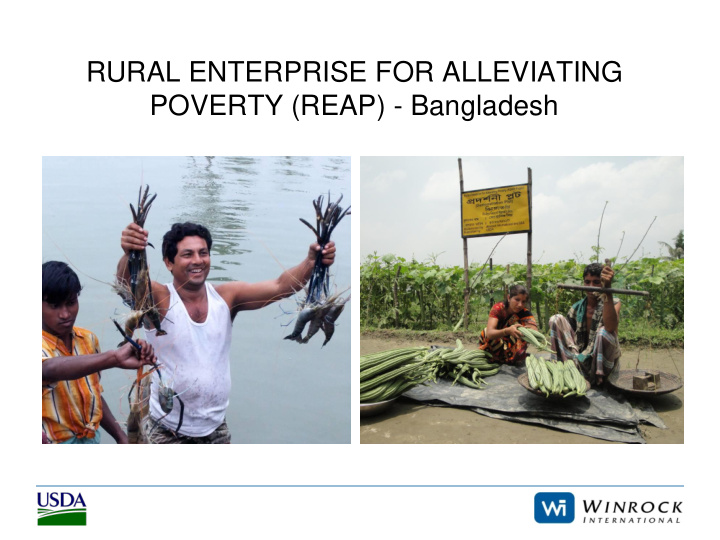



RURAL ENTERPRISE FOR ALLEVIATING POVERTY (REAP) - Bangladesh
REAP • Feb. 2009 – Sept. 2011 • Funded by U.S. Department of Agriculture • Implemented by Winrock International • Partnered with Society for Social Service, Bangladesh Association for Social Advancement • Coordinated with Department of Fisheries, Government of Bangladesh • Estimated Cost: BDT 50.00 million (U.S. $724,600)
Problems • Widespread food insecurity in Bangladesh • High malnutrition rates • High poverty and population density • Limited access to land and assets • Susceptible to economic, environmental distress 3
Solutions • Increase productivity of rural resources • Introduce eco-friendly practices • Promote rural enterprise • Strengthen value chains • Form farmer associations and production groups • Strengthen capacity of farmers, service providers, market actors, and NGOs • Establish market channels to ensure fair prices
REAP in Bangladesh • Mymensingh: (5 upazilas) • Tangail: (3 upazilas) • Gazipur: (3 upazilas)
Baseline Survey • 4,500+ farmers’ ponds, horticulture and households status surveyed
Capacity Building: Field Staff • Aquaculture, horticulture, and production group development • HACH water testing kit
Aquaculture & Horticulture Training • 165 demo farmers • 2,200 fellow farmers • 1,977 women beneficiaries • 1,809 farmers in refresher courses 8
Training Input Providers • Quality maintenance • Market development • Providing input buyers with technical advice
Capacity Building: Farmer Association Leaders • Capacity building • Leadership development
Sharing the Experience • Daudkandi model integrated aquaculture, Comilla • BRAC prawn hatchery, Rajendrapur, Gazipur • Fish processing plant, Kuliarchar
Crates for Hygiene • 282 crates distributed for transporting fish/prawn hygienically
Horticulture Demonstration • 121 demo-farmers produced 138 metric tons (estimated) of Cucumber, Ridge gourd, Sponge gourd, Papaya, Bitter gourd, Bottle gourd, and Country bean in 8.57 acres ponds dike and homestead land in 2 years • Additional Income: Around BDT 1,716,600 (US $25,016)
Horticulture Demonstration 20 16 m. ton/acre 15 10 5 5 0 General plot Demonstration plot Yield (metric ton/acre) in horticulture demonstration plots
Fellow- Farmers’ Land • Various seeds distributed to 2,200 farmers for 3 growing seasons • About 1,955 m. tons produced in 2 years • Created additional income: BDT 24,320,200 (US $354,419)
Collaboration with BAU • Collaborated with GPC of Bangladesh Agricultural University (BAU) for horticultural activities • 700 lemon saplings distributed among 8 farmers for demonstration – 2.25 m. ton of lemon will be produced annually • 2,250 mango saplings distributed among 1,041 farmers for economic and nutritional purposes – 162 m. ton of mango will be produced annually
Prawn-Carp Aquaculture • 501,889 juveniles produced • 60 farmers • Average survival 52%, maximum 95% • Additional income: Around BDT 3,671,023 (US $53,498)
Prawn-Carp Aquaculture • 105 demos conducted in 26.30 acre ponds by farmers • Farmers produced 4,789 kg of prawn and 22,315 kg of carp • Income: BDT 4,626,000 (US $67,415)
Prawn-Carp Mixed Culture Expansion • 2,200 farmers received partial support of 308,370 prawn juveniles and 419,200 carp fingerlings • Produced 17,215 kg of prawn, 268,288 kg of carp • Additional Income: Around BDT 35,436,300 (US $516,414)
Value Chain Linkages • Workshops: aquaculture & horticulture • Representatives: hatcheries, nurseries, feed companies, input suppliers, service providers, seed companies, seed retailers, plant nurseries
Farmer to Farmer Support • Value chain development training and workshop • Training on Low External Input Agriculture (LEIA) and Organic Farming Practices for Horticultural Products • Capacity Enhancement for Pond Fish Production Extension • Community Development through Involvement of Women in the agricultural enterprise activities under REAP Project
Economic Benefits 46.26 50 40 24.42 30 US$ 20 10 0 Basline After project intervention Average monthly income (US$) of project beneficiary families
Targets and Achievements Intervention Target Achievement Training of farmers 4,025 4,177 Training of input suppliers and value chain actors 150 300 Workshop (#) 6 21 Horticulture demonstration 72 129 Aquaculture demonstration 72 165 Prawn production (kg/acre/year) 120 182 Fish production (kg/acre/year) 1,300 1,557 Farmers Association 36 84 Entrepreneurs development in aquaculture and horticulture 12 16 Direct beneficiaries 2,350 2,500 Indirect beneficiaries 10,575 12,250 Total beneficiaries 12,925 14,750
Targets and Achievements 20,000 17,828 kilogram/acre/year 15,000 10,000 5,000 5,000 1,559 1,300 0 Fish Horticulture Target Achievement Average yield (kilogram/acre/year) from horticulture and aquaculture after project intervention
Targets and Achievements 200 182 180 kilogram/acre/year 160 140 120 120 100 80 60 40 20 0 Target Achievement Average production (kilogram/acre/year) prawn in farmer’s pond
Impacts • Technical capacity increased • Women involved in horticulture and agro-enterprise • Farmers organized in production group approach • Linkage of input/service providers and market actors established • Production of crops and aquaculture increased • Farmers get better prices • Poverty reduced • Farmers’ families get more nutritious foods • Partners, NGOs encouraged to continue supports
Lessons Learned • Adequate number of prawn nurseries • Prawn farming suitable for progressive farmers • Tilapia, catfish, perch should be cultured in addition to prawn-carp farming • Rural farmers interested in adopting high-value horticultural farming • Homogeneous production groups more effective than heterogeneous • As prawn farming expands, relevant input suppliers coming forward • Women feel comfortable forming separate production groups • Livestock farming should be incorporated with agro-aquaculture • Group approach more effective than individual approach • Backward and forward linkage a must for sustainable rural agro- enterprise
Recommend
More recommend